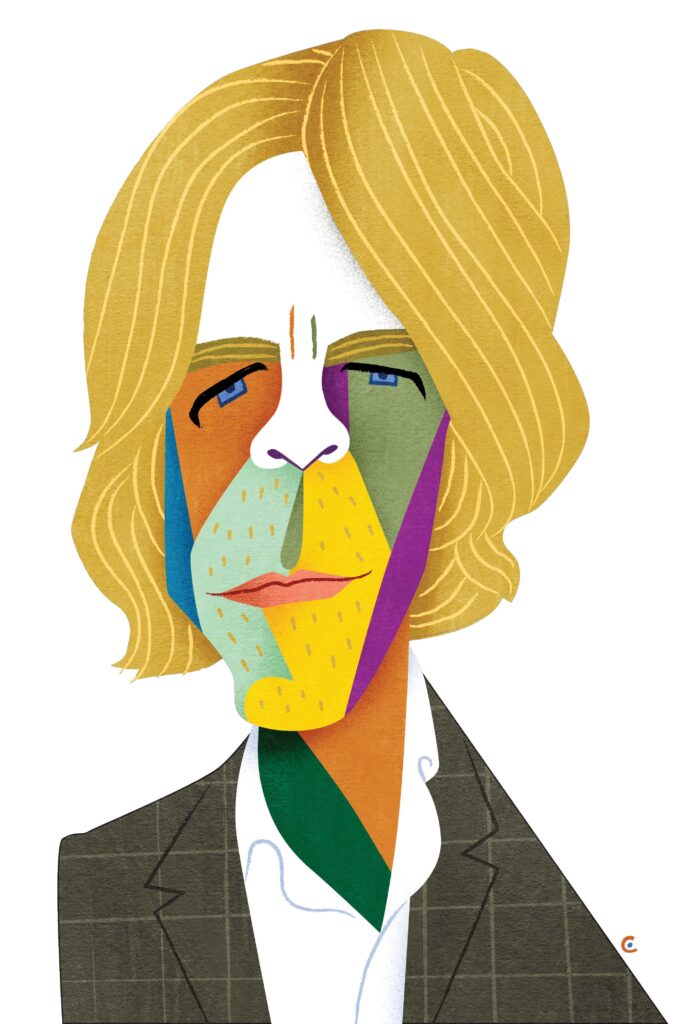The Aesthetics of Imperfection
The Aesthetics of Imperfection
Through a deep dive into an iconic album, Warren Zanes ’02 (PhD) explores a lost virtue in recorded music.

(Illustration: David Cowles for Rochester Review)
I’ve written songs almost my entire life. I became part of a roots-rock band, the Del Fuegos, in the early 1980s, when I was 17. I went to college after I left the group and continued to write songs. I was writing songs in Rochester, when I was a student in the visual and cultural studies program. Those actually became my first solo album, Memory Girls.
I’ve been working on a book, just out, about the making of a single album in 1982: Bruce Springsteen’s Nebraska. Some records stay with you, and Nebraska has been that for me. It’s mysterious. It’s imperfect and unfinished. And to come out with a record like that when you’ve just been in the top 10 of the popular music charts was unthinkable. I wanted to know why he did it. And answering that question was going to take me years—until I sat down with him and got to ask. And I don’t think he has an answer fully in the can.
The imperfections in the music were significant, and I say this knowing plenty of imperfect records had come before. But that was mostly music that lived out on the margins. This was imperfect music right in the hot center of the marketplace.
One of the things that makes this record a touchstone is that around 1982 recorded music was stepping into the digital era. It was the same year Time magazine’s person of the year was the personal computer. And for music makers, the digital era was when the possibility of making perfect music became more accessible with every passing year.
When people started recording music digitally, they started looking at music as waveforms. Engineers who used to close their eyes and listen were now opening their eyes and looking. And they would see, for instance, where a vocal is off pitch. Or when the drummer starts to speed up.
The problem—and I’m going to label it a problem—is that it became harder to resist fixing the imperfections. I’m not talking about EDM [electronic dance music], which lives on the grid, but music made by human beings playing instruments in a room.
Bruce made Nebraska sitting on his bed and turning songs into recordings on a little cassette. He didn’t mean for them to go anywhere. They were meant to be a reference so he could go rerecord them. Then he said, “I don’t know what happened, but I can’t make this better. I have to put it out like this.”
Musicians did often prefer their demos to the final product. The magic of a demo was that you just focused on the song and getting to know it. There was an absence of scrutiny. In the studio, there’d be an engineer, a producer, a band—everybody looking at you.
I tell people, in addition to Nebraska, go listen to the Beach Boys’ “Wild Honey.” The Beach Boys are known for these gorgeous harmonies, and in “Wild Honey” there’s so much joy and abandon in that vocal. If that were recorded today, the engineer would really work it over.
But sometimes the best, most emotionally resonant music, isn’t perfect. It changes speed. The pitch wavers. And there’s an intimacy to that.
Warren Zanes ’02 (PhD)
Scholar, teacher, musician
Faculty member, NYU Steinhardt program in songwriting; former vice president of education, Rock and Roll Hall of Fame
Books: Deliver Me from Nowhere: The Making of Bruce Springsteen’s Nebraska (2023); Petty: The Biography (2015); Revolutions in Sound: Warner Bros. Records, the First Fifty Years (2008); Dusty in Memphis (2003)
First solo recording:
Memory Girls (2003)
Most recent recording:
The Biggest Bankrupt City in the World (2020)
— Interview by Karen McCally ’02 (PhD)
This article originally appeared in the spring 2023 issue of the Rochester Review magazine.


